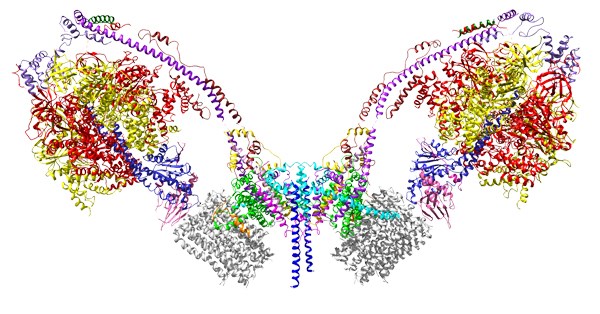Visualizing the invisible: SickKids scientists determine structure of cellular powerhouse for the first time
Summary:
Published Oct. 26 online in Science, scientists at The Hospital for Sick Children (SickKids) determined the structure of the energy powerhouse within our cells, the mitochondrial ATP synthase, for the first time at sufficient resolution to reveal the arrangement of its atoms.
For decades scientists have been trying to determine the structure that enables a fundamental process within our cells: mitochondrial ATP synthase. Mitochondria are the power-packs of cells and the ATP synthase transfers the energy from mitochondria to the energy form that cells and tissues can use (ATP). For cells that rely on oxygen, almost all the power of the cell goes through this machine, but until now, scientists didn’t know what it looked like – a key piece of information to understanding how it works.
Published Oct. 26 online in Science, scientists at The Hospital for Sick Children (SickKids) determined the structure of the energy powerhouse within our cells, the mitochondrial ATP synthase, for the first time at sufficient resolution to reveal the arrangement of its atoms.
“If you’re trying to fix a car, you need to take a good look at the engine. If you can’t see the machinery, you won’t know how the car works or how to fix problems that may arise. This analogy can be applied to understanding the complex machinery of our cells. Without knowing what these cellular structures look like and how their structure controls their function, essentially we are working blind,” says Dr. John Rubinstein, Senior Scientist in Molecular Medicine at SickKids and Professor in the Departments of Biochemistry and Medical Biophysics at the University of Toronto. “Because of the central role ATP synthases plays in controlling energy in cells, they are increasingly important drug targets.
An example of a drug that targets this process is bedaquiline, the first new anti-TB drug approved in more than 40 years, for use in treating extensively drug resistant tuberculosis. Rubinstein explains, “this drug proved that ATP synthase inhibitors can work as drugs. Our structure can help inform on the development of future better drugs by allowing design and refinement of molecules that specifically inhibit bacterial ATP synthase, but not human ATP synthase.”
Visualizing the invisible
In the study led by Mr. Hui Guo, a PhD student at SickKids, Rubinstein and his team used a technique called cryo-electron microscopy to produce a very high-resolution image of mitochondrial ATP synthase, which measures around 20 nm across, or 1/5,000 of the thickness of a piece of paper. The structure was determined with sufficient clarity to resolve features that are separated by around 0.35 nm, 1/300,000 of the thickness of a piece of paper.

The technology has been widely recognized recently for revolutionizing biochemistry. In fact, the Nobel Prize in Chemistry 2017, announced earlier this month, was awarded to three scientists including Richard Henderson, who was one of Rubinstein’s PhD advisors at the Medical Research Council Laboratory for Molecular Biology in Cambridge, U.K., “for the development of cryo-electron microscopy, which both simplifies and improves the imaging of biomolecules.”
SickKids, University Health Network, and the University of Toronto, Faculty of Medicine together committed approximately $6 million for a new high-resolution cryo-electron microscopy facility that will produce structures at higher-resolution and with higher-throughput. A grant recently awarded by Canada Foundation for Innovation will contribute to this total. It is one of three of its kind in Canada and is housed at The Peter Gilgan Centre for Research and Learning at SickKids.
This study was supported by Canadian Institutes of Health Research, the Canada Research Chairs Program, the NIH National Institute of General Medical Sciences, the Simons Foundation and SickKids Foundation. It is an example of how SickKids is contributing to making Ontario Healthier, Wealthier and Smarter. www.healthierwealthiersmarter.ca.

